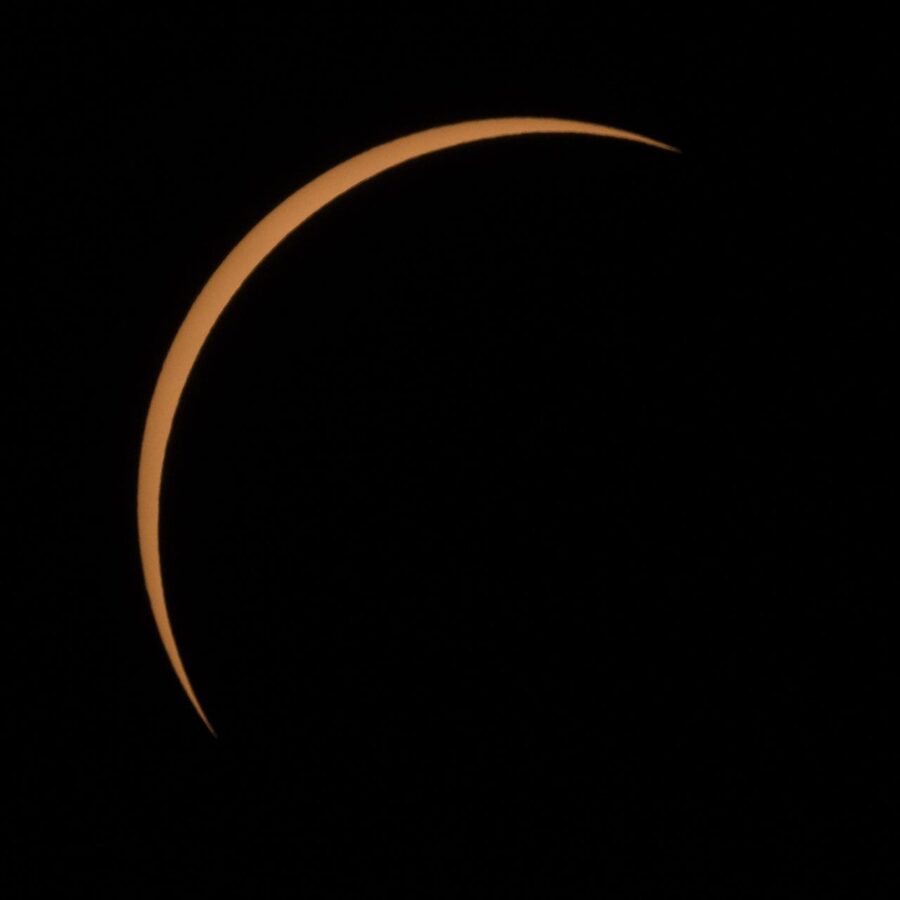A total solar eclipse — when the sun, moon and Earth align and the sun’s light is blocked — happens about every 18 months. It’s not a rare event, but it is less common in populated areas, especially in the US. The most recent total solar eclipse happened in 2017, when the DMV saw about 80% coverage of the sun, The Washington Post reported.
While DC is not in the path of totality on April 8, the partial eclipse will still be a unique experience. There won’t be another total solar eclipse visible in the US until 2044, and DC will not be in the path at all that year. DC hasn’t witnessed a total solar eclipse in several centuries, according to a NASA tracker.
The region will reach about 87% of lunar coverage this year. The partial eclipse will be visible between 2:04 p.m. and 4:32 p.m., with the most coverage at 3:20 p.m., per NASA’s tracking tool. Parts of Maryland and Virginia will have slightly different coverage.
The closest areas to the path of totality are Erie, Pennsylvania, and Cleveland, Ohio. The path will also cut through Oklahoma, Arkansas, Missouri, Illinois, Kentucky, Indiana, Ohio, Pennsylvania, New York, Vermont, New Hampshire and Maine.
If you can travel to see the total solar eclipse, you should, said Eric Christian, a senior research scientist at the NASA Goddard Space Flight Center in Greenbelt.
“It really is day and night between a total eclipse and a partial eclipse,” Christian said.
Christian will be traveling to Junction, Texas for his fourth time witnessing an eclipse in the path of totality. He previously went to western China in 2008, Micronesia in 2016 and Casper, Wyoming, in 2017.
Samantha Thompson, the astronomy curator at the National Air and Space Museum, said while it’s different, the partial eclipse will still be a cool sight to see. For about two and a half hours, people will slowly see the moon cover the sun, and it will feel like you’re sitting in the shade.
She’s heading to Mazatlan, Mexico — another North American city within the path of totality — to see the eclipse. She first saw a total solar eclipse in 2017. She was amazed.
“Everyone said how amazing it would be, and it was beyond that,” Thompson said. “So I am hooked.”
Christian compared the total eclipse to all old Western movies, when filmmakers would put a filter over the camera while filming nighttime-set scenes during the day.
“It’s dark, but there are really sharp shadows. And it’s eerie,” Christian said.
Elizabeth Warner, the University of Maryland Observatory director, also said it’s very much worth the trip to the path of totality if you can make the journey.
“It is a fairly deep partial eclipse solar eclipse for us. So it’ll be kind of interesting,” Warner said. “But it certainly won’t be like being in the path of totality.”
How to watch safely
It’s necessary to wear proper eye protection when viewing the eclipse, whether in its totality or partial, Warner said.
“Do not look at the sun with anything other than an approved solar filter,” she said.
Eclipse glasses can be purchased online, and Warner encouraged people to buy them quickly so they arrive in time. Several eclipse viewing events will also be handing out glasses to observe the partial eclipse. The National Air and Space Museum also has a guide on where to find or purchase glasses, as well.
Where to watch in the DMV
Several events are happening in the DMV to celebrate. Below are a few of the festivities planned.
- There will be a Solar Eclipse Festival on the National Mall between 4th and 12th Streets from noon to 4 p.m. It takes place in collaboration with other Smithsonian museums, NASA, NOAA, the National Science Foundation and the National Radio Astronomy Observatory. Attendees are encouraged to bring their own eclipse glasses, but there will be a limited supply at the event.
- The NASA Goddard Visitor Center is hosting a viewing event including scientific presentations by solar scientists.
- There will be a viewing event at Observatory Park in Gaithersburg, Maryland.
- The Turner Farm in Great Falls, Virginia is putting together a viewing event, and attendees will receive a free pair of solar viewing glasses.
- At the University of Maryland, people will gather on the Front Lawn of Glenn L. Martin Hall between 1:45 p.m. and 4:45 p.m. to watch the eclipse.
Have another we should add? Let us know by emailing dc@technical.ly.







